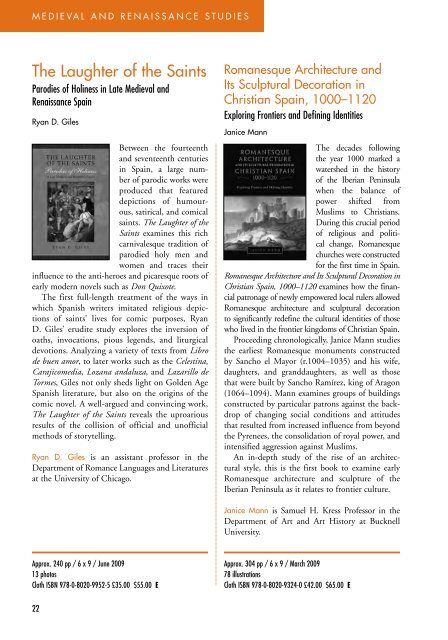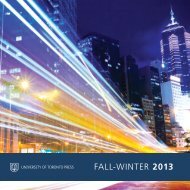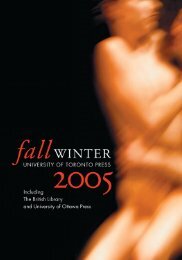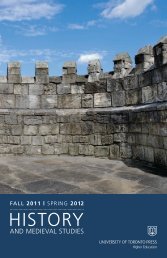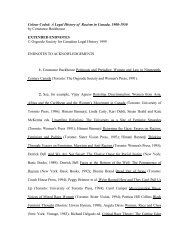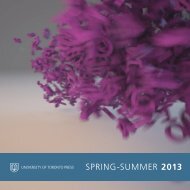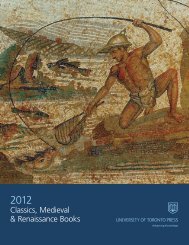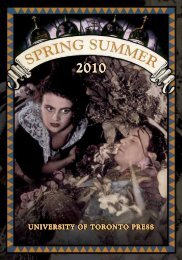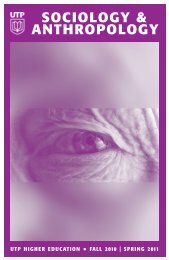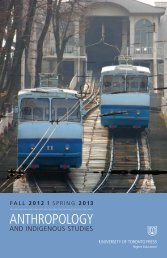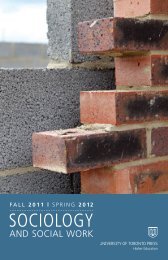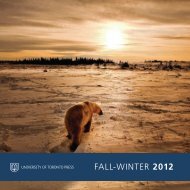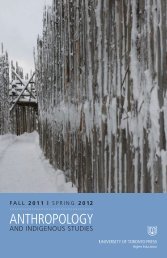Spring/Summer 2009 - University of Toronto Press Publishing
Spring/Summer 2009 - University of Toronto Press Publishing
Spring/Summer 2009 - University of Toronto Press Publishing
You also want an ePaper? Increase the reach of your titles
YUMPU automatically turns print PDFs into web optimized ePapers that Google loves.
gm end i er va a l l ian nt ed r er se tn a i s s a n c e s t u d i e s<br />
The Laughter <strong>of</strong> the Saints<br />
Parodies <strong>of</strong> Holiness in Late Medieval and<br />
Renaissance Spain<br />
Ryan D. Giles<br />
Between the fourteenth<br />
and seventeenth centuries<br />
in Spain, a large number<br />
<strong>of</strong> parodic works were<br />
produced that featured<br />
depictions <strong>of</strong> humourous,<br />
satirical, and comical<br />
saints. The Laughter <strong>of</strong> the<br />
Saints examines this rich<br />
carnivalesque tradition <strong>of</strong><br />
parodied holy men and<br />
women and traces their<br />
influence to the anti-heroes and picaresque roots <strong>of</strong><br />
early modern novels such as Don Quixote.<br />
The first full-length treatment <strong>of</strong> the ways in<br />
which Spanish writers imitated religious depictions<br />
<strong>of</strong> saints’ lives for comic purposes, Ryan<br />
D. Giles’ erudite study explores the inversion <strong>of</strong><br />
oaths, invocations, pious legends, and liturgical<br />
devotions. Analyzing a variety <strong>of</strong> texts from Libro<br />
de buen amor, to later works such as the Celestina,<br />
Carajicomedia, Lozana andaluza, and Lazarillo de<br />
Tormes, Giles not only sheds light on Golden Age<br />
Spanish literature, but also on the origins <strong>of</strong> the<br />
comic novel. A well-argued and convincing work,<br />
The Laughter <strong>of</strong> the Saints reveals the uproarious<br />
results <strong>of</strong> the collision <strong>of</strong> <strong>of</strong>ficial and un<strong>of</strong>ficial<br />
methods <strong>of</strong> storytelling.<br />
Ryan D. Giles is an assistant pr<strong>of</strong>essor in the<br />
Department <strong>of</strong> Romance Languages and Literatures<br />
at the <strong>University</strong> <strong>of</strong> Chicago.<br />
Romanesque Architecture and<br />
Its Sculptural Decoration in<br />
Christian Spain, 1000–1120<br />
Exploring Frontiers and Defining Identities<br />
Janice Mann<br />
The decades following<br />
the year 1000 marked a<br />
watershed in the history<br />
<strong>of</strong> the Iberian Peninsula<br />
when the balance <strong>of</strong><br />
power shifted from<br />
Muslims to Christians.<br />
During this crucial period<br />
<strong>of</strong> religious and political<br />
change, Romanesque<br />
churches were constructed<br />
for the first time in Spain.<br />
Romanesque Architecture and Its Sculptural Decoration in<br />
Christian Spain, 1000–1120 examines how the financial<br />
patronage <strong>of</strong> newly empowered local rulers allowed<br />
Romanesque architecture and sculptural decoration<br />
to significantly redefine the cultural identities <strong>of</strong> those<br />
who lived in the frontier kingdoms <strong>of</strong> Christian Spain.<br />
Proceeding chronologically, Janice Mann studies<br />
the earliest Romanesque monuments constructed<br />
by Sancho el Mayor (r.1004–1035) and his wife,<br />
daughters, and granddaughters, as well as those<br />
that were built by Sancho Ramírez, king <strong>of</strong> Aragon<br />
(1064–1094). Mann examines groups <strong>of</strong> buildings<br />
constructed by particular patrons against the backdrop<br />
<strong>of</strong> changing social conditions and attitudes<br />
that resulted from increased influence from beyond<br />
the Pyrenees, the consolidation <strong>of</strong> royal power, and<br />
intensified aggression against Muslims.<br />
An in-depth study <strong>of</strong> the rise <strong>of</strong> an architectural<br />
style, this is the first book to examine early<br />
Romanesque architecture and sculpture <strong>of</strong> the<br />
Iberian Peninsula as it relates to frontier culture.<br />
Janice Mann is Samuel H. Kress Pr<strong>of</strong>essor in the<br />
Department <strong>of</strong> Art and Art History at Bucknell<br />
<strong>University</strong>.<br />
Approx. 240 pp / 6 x 9 / June <strong>2009</strong><br />
13 photos<br />
Cloth ISBN 978-0-8020-9952-5 £35.00 $55.00 E<br />
Approx. 304 pp / 6 x 9 / March <strong>2009</strong><br />
78 illustrations<br />
Cloth ISBN 978-0-8020-9324-0 £42.00 $65.00 E<br />
22


